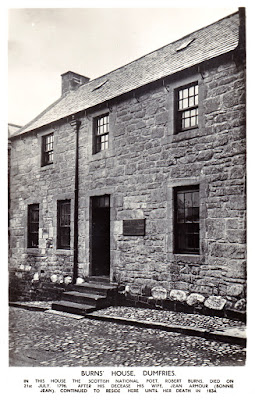Burns Country, Ayrshire :
 |
| A rather romanticised 1930's(?) souvenir booklet describing many Burns related places of interest in Ayrshire |
Burns' Cottage, Alloway, Ayrshire :
 |
| A teapot stand featuring Burns' Cottage at Alloway |
 |
Burns' Cottage, Alloway, as viewed on a 1907 postcard.
Note the tram track in foreground which has
long since been removed.
|
 |
| A 'Mauchline Ware' shot glass and holder "bought in the Cottage" and bearing an engraving of the cottage itself |
 |
| A sycamore wood 'Mauchline Ware' box, also, "Bought in the Cottage" |
Alloway Auld Kirk and the Story of "Tam o'Shanter" :
The ruinous 16th century "Auld Kirk" at Alloway is celebrated as the scene of Burns' poem where "Tam o'Shanter", after drinking till late with his cronies at Kirkton Jean's, heads home drunk on his horse Meg as a storm is brewing. On the way Tam happens upon the Auld Kirk all lit up and spies the witches and warlocks dancing as the devil plays the bagpipes. My elderly Great Aunt recalled that when she was a very young girl her father raised her up to the kirk window and asked "Dae ye see the witches?". I believe she was suitably scared.
With the witches in hot pursuit Tam escapes on his horse Meg by crossing the nearby River Doon at the Brig o'Doon (as witches would not cross a running stream) but not before the witch pulls off Meg's tail!
 |
| Tam o'Shanter and his cronies drinking at Kirkton Jean's during the evening |
 |
| Tam o'Shanter, with a witch in hot pursuit, riding his horse Meg towards the River Doon and safety (as witches would not cross a running stream) |
 |
| The Auld Brig o'Doon over the River Doon at Alloway with the Tea Gardens in foreground. This is the bridge that Tam o"Shanter crossed on his horse "Meg". |
 |
| The Burns Monument overlooking the Tea Gardens, Alloway |
"Arms For Burns" :
 |
| "Arms For Burns" Salt and Pepper Shakers |
In 1794 Robert Burns designed an armorial crest or coat of arms for himself to place on his seal, being,
"On a field, azure, a holly-bush, seeded, proper, in base; a Shepherd's pipe and crook, Saltier-wise, also proper, in chief. - On a wreath of the colours, a woodlark perching on a sprig of bay-tree, proper, for Crest - 'Woodnotes Wild' - At the bottom of the Shield in the usual place - Better a wee bush than nae bield'.
The Twa Brigs O'Ayr :
 |
| The "Twa Brigs O' Ayr" prior to 1907 |
Burns immortalised the river bridges at Ayr when he wrote "The Brigs of Ayr", being first published in 1787. This is essentially a dialogue between the old and new bridge, in which the 'Auld Brig' berates the New Bridge and predicts that it shall remain standing long after its replacement has gone. Here is a short extract where the 'Auld Brig' predicts the destruction of its replacement :
"[From] The New Brig -
"There's men of taste wou'd tak the Ducat stream,
Tho' they should cast the very sark and swim,
E'er they would grate their feelings wi' the view
O' sic an ugly, Gothic hulk as you.”
[From] The Auld Brig -
"Conceited gowk! puff'd up wi' windy pride!This mony a year I've stood the flood an' tide;
And tho' wi' crazy eild I'm sair forfairn ,
I'll be a brig when ye're a shapeless cairn!"
 |
| Robert Burns - from an engraving in "The Poetical Works of Robert Burns", printed by Bernhard Tauchnitz, Leipzig, Germany, 1845 |
Burns' House at Dumfries :
Robert Burns spent his final years living in Dunfries and died here on the morning of the 21st July 1796. Burns was at first buried in St. Michael's Churchyard in Dumfries with a simple "slab of freestone" erected over his gravestone by his widow, Jean Armour. As some felt that this was insulting to his revered memory his body was eventually moved to the Burns Mausoleum in the same cemetery. His wife, Jean Armour, was buried with him in 1834.
 |
| Burns' House at Dumfries where he died in 1796 |
 |
| The interior of Burns' House at Dumfries, as shown on a postcard in 1909 |
 |
| Burns' widow Jean Armour shown with her Granddaughter |
Finally, A Fatal Mistake :
 |
| A modern cameo of the likeness of Robert Burns painted by Alexander Nasmyth in 1787 |
It is rather amusing to note the somewhat differing opinion of Burns held by the early Scottish settlers in Otago New Zealand. While they would have celebrated the poetical works of Robert Burns (and after all, their 'founding father' was his own nephew, the highly respected Rev Thomas Burns), there was apparently a time and a place for everything and never the twain shall meet!
The story is told of a newly licensed student Minister who had been invited to conduct a service in a country Parish in the south. Although he conducted the service with due reverence and all found the subject of his Sermon - and more importantly himself - most acceptable, he made one fatal mistake and thus a "call" was not extended to him to become their next Minister.
For Auld Lang Syne :
 |
| The words and music to "Auld Lang Syne" |
Sources :
- Personal and family artefacts
- Presbyterian Research Centre (Archives), Dunedin, New Zealand
- Various Internet resources




No comments:
Post a Comment